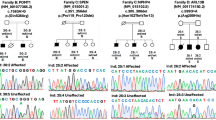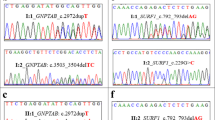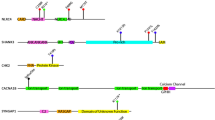Abstract
On whole-exome sequencing, a novel compound heterozygous mutation (c.2923A>G/c.3523_3524insTGTCCG, p.T975A/p.1175_1176insVS) and a novel homozygous one (c.3534G>C, p.W1178C) in the PNPLA6 gene were identified in sporadic and familial Japanese patients with Boucher-Neuhäuser syndrome (BNS), respectively. However, we did not find any mutations in the PNPLA6 gene in 88 patients with autosomal recessive hereditary spastic paraplegia (ARHSP). Our study confirmed the earlier report that a PNPLA6 mutation causes BNS. This is the first report on PNPLA6 mutations in non-Caucasian patients. Meanwhile, PNPLA6 mutations might be extremely rare in Japanese ARHSP patients. Moreover, we first found hypersegmented neutrophils in two BNS patients with PNPLA6 mutations.
Similar content being viewed by others
Log in or create a free account to read this content
Gain free access to this article, as well as selected content from this journal and more on nature.com
or
References
Holmes, G . A form of familial degeneration of the cerebellum. Brain 30, 466–489 (1907).
Boucher, B. J . & Gibberd, F. B . Familial ataxia, hypogonadism and retinal degeneration. Acta Neurol. Scand. 45, 507–510 (1969).
Neuhauser, G . & Opitz, J. M . Autosomal recessive syndrome of cerebellar ataxia and hypogonadotropic hypogonadism. Clin. Genet. 7, 426–434 (1975).
Margolin, D. H., Kousi, M., Chan, Y. M., Lim, E. T., Schmahmann, J. D . & Hadjvassiliou, M. et al. Ataxia, dementia, and hypogonadotropism caused by disordered ubiquitination. N. Engl. J. Med. 368, 1992–2003 (2013).
Rainier, S., Bui, M., Mark, E., Thomas, D., Tokarz, D . & Ming, L. et al. Neuropathy target esterase gene mutations cause motor neuron disease. Am. J. Hum. Genet. 82, 780–785 (2008).
Synofzik, M., Gonzalez, M. A., Lourenco, C. M., Coutelier, M., Haack, T. B . & Rebelo, A. et al. PNPL6 mutations cause Boucher-Neuhauser and Gordon Holmes syndromes as part of a broad neurodegenerative spectrum. Brain 137, 69–77 (2014).
Synofzik, M . & Züchner, S . in: Gene Review (R) (eds Pagon, R. A., Adam, M. P., Ardinger, H. H., Bird, T. D., Dolan, C. R., Fong, C. T., et al.) 1993–2014 (University of Washington, Seattle, WA, 2014).
Umehara, T., Yaguchi, H., Suzuki, M., Isozaki, E . & Mochio, S . Are hypersegmented neutropils a characteristic of Boucher-Neuhauser syndrome? J. Neurol. Sci. 295, 128–130 (2010).
Jbour, A. K., Mubaidin, A. F., Till, M., El-Shanti, H., Hadidi, A . & Ajlouni, K. M . Hypogonadotrophic hypogonadism, short stature, cerebellar ataxia, rod-cone retinal dystrophy, and hypersegmented neutrophils: a novel disorder or a new variant of Boucher-Neuhauser syndrome? Med. Genet. 40, e2 (2003).
Kobayashi, F., Kurihara, Y., Nagasaka, K., Iida, H., Shindo, K . & Takiyama, Y . A patient with cerebellar ataxia, hypogonadotropic hypogonadism and vitelliform macular dystrophy: Boucher-Neuhäuser syndrome [in Japanese]. Rinsho Shinkeigaku 50, 98–102 (2010).
Li, H . & Durbin, R . Fast and accurate short read alignment with Burrows-Wheeler transform. Bioinfomatics 38, 1767–1771 (2010).
McKenna, A., Hannna, M., Banks, E., Sivachenko, A., Cibulskis, K . & Kernytsky, A. et al. The Genome Analysis Toolkit: a MapReduce framework for analyzing next-generation DNA sequencing data. Genome Res. 20, 1297–1303 (2010).
Li, H., Handsaker, B., Wysoker, A., Fennell, T., Ruan, J . & Homer, N. et al. The Sequence Alignment/Map format and SAMtools. Bioinfomatics 25, 2078–2079 (2009).
Tarnutzer, A. A., Gerth-Kahlert, C., Timmann, D., Chang, D. I., Harmuth, F . & Bauer, P. et al. Boucher-Neuhäuser syndrome: cerebellar degeneration, chorioretinal dystrophy and hypogonadotropic hypogonadism: two novel cases and a review of 40 cases from the literature. J. Neurol. 262, 194–202 (2014).
Deik, A., Johannes, B., Rucker, J. C., Sanchez, E., Brodie, S. E . & Deegan, E. et al. Compound heterozygous PNPLA6 mutations cause Boucher-Neuhäuser syndrome with late-onset ataxia. J. Neurol. 261, 2411–2423 (2014).
Synofzik, M., Kernstock, C., Haack, T. B . & Shöls, L . Ataxia meets chorioretinal dystrophy and hypogonadism: Boucher-Neuhäuser syndrome due to PNPLA6 mutations. J. Neurol. Neurosurg. Psychiatry (e-pub ahead of print 30 April 2014; doi:10.1136/jnnp-2014-307793.
Yoon, G., Baskin, B., Tarnopolsky, M., Boycott, K. M., Geraghty, M. T . & Sell, E. et al. Autosomal recessive hereditary spastic paraplegia-clinical and genetic characteristics of a well-defined cohort. Neurogenetics 14, 181–188 (2013).
Topaloglu, A. K., Lomnicze, A., Kretzschmar, D., Dissen, G. A., Kotan, L. D . & McArdle, C. A. et al. Loss-of-function mutations in PNPLA6 encoding neuropathy target esterase underlie pubertal failure and neurological deficits in Gordon Holmes syndrome. J. Clin. Endocrinol. Metab. 10, E2067–E2075 (2014).
Hufnagel, R. B., Arno, G., Hein, N. D., Hersheson, J., Prasad, M . & Anderson, Y. et al. Neuropathy target esterase impairments cause Oliver-McFarlane and Laurence-Moon syndromes. J. Med. Genet. (e-pub ahead of print 5 December 2014; doi:10.1136/jmedgenet-2014-102856.
Fogel, B. L., Lee, H., Deignan, J. L., Strom, S. P., Kantarci, S . & Wang, X. et al. Exome sequencing in the clinical diagnosis of sporadic or familial cerebellar ataxia. JAMA Neurol. 71, 1237–1246 (2014).
Johnson, M. K . A phosphorylation site in brain and the delayed neurotoxic effect of some organophosphorus compounds. Biochem. J. 111, 487–495 (1969).
Winrow, C. J., Hemming, M. L., Allen, D. M., Quistad, G. B., Casida, J. E . & Barlow, C . Loss of neuropathy target esterase in mice links organophosphate exposure to hyperactivity. Nat. Genet. 33, 477–485 (2003).
Akassoglou, K., Malester, B., Xu, J., Tessarollo, L., Rosenbluth, J . & Chao, M. V . Brain-specific deletion of neuropathy target esterase/swisscheese results in neurodegeneration. Proc. Natl Acad. Sci. USA 101, 5075–5080 (2004).
Richardson, R. J., Hein, N. D., Wijeyesakere, S. J., Fink, J. K . & Makhaeva, G. F . Neuropathy target esterase (NTE): overview and future. Chem. Biol. Interact. 203, 238–244 (2013).
Yoshida, T., Awaya, T., Shibata, M., Kato, T., Numabe, H . & Kobayashi, J. et al. Hypergonadotropic hypogonadism and hypersegmented neutrophils in a patient with ataxia-telangiectasia-like disorder: potential diagnostic clues? Am. J. Med. Genet. A 167, 1830–1834 (2014).
Acknowledgements
We thank the Japan Spastic Paraplegia Research Consortium (JASPAC) for sending us the DNA from patients with autosomal recessive spastic paraplegia. This work was supported by Grants-in-Aid from the Research Committee for Ataxic Disease, the Ministry of Health, Labour and Welfare of Japan.
Accession Numbers
The nucleotide sequence data reported are available in the GenBank database under the accession numbers: KJ885304, KJ885305, KJ885306, KJ885307, KJ885308, KJ885309, KJ885310.
Author information
Authors and Affiliations
Corresponding author
Ethics declarations
Competing interests
The authors declare no conflict of interest.
Rights and permissions
About this article
Cite this article
Koh, K., Kobayashi, F., Miwa, M. et al. Novel mutations in the PNPLA6 gene in Boucher-Neuhäuser syndrome. J Hum Genet 60, 217–220 (2015). https://doi.org/10.1038/jhg.2015.3
Received:
Revised:
Accepted:
Published:
Issue date:
DOI: https://doi.org/10.1038/jhg.2015.3
This article is cited by
-
Different Cerebellar Ataxia Phenotypes Associated with Mutations of the PNPLA6 Gene in Brazilian Patients with Recessive Ataxias
The Cerebellum (2018)
-
Systematic review of autosomal recessive ataxias and proposal for a classification
Cerebellum & Ataxias (2017)
-
Nuclear morphologies: their diversity and functional relevance
Chromosoma (2017)
-
Pure Cerebellar Ataxia with Homozygous Mutations in the PNPLA6 Gene
The Cerebellum (2017)
-
The destruction box is involved in the degradation of the NTE family proteins by the proteasome
Molecular Biology Reports (2016)



